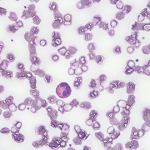E. Acrodermatitis chronica atrophicans (ACA): ACA results from chronic Lyme disease infection, most commonly caused by persistence of Borrelia afzelii in the skin. Months to years after initial infection, patients demonstrate erythema, edema and scaling of the extremities, which can last for years. Later, they develop atrophic, shiny, wrinkled plaques, with prominent vasculature and fibrotic bands that are usually resistant to therapeutic intervention. Although acute ACA can have features that overlap with EF, the end-stage sequelae differ significantly. In addition to physical examination findings, Lyme titers can help differentiate the two entities.
Natalie A. Wright, MD, is the dermatology-rheumatology fellow at Brigham and Women’s Hospital in Boston. She is a diplomat of the American Board of Dermatology.
Joseph F. Merola, MD, MMSc, FAAD, FACR, is instructor at Harvard Medical School, director of the Center for Skin and Related Musculoskeletal Diseases and director of Clinical Trials at the Brigham and Women’s Hospital, Department of Dermatology and Department of Medicine, Division of Rheumatology.
References
- Asano Y, Hironobu I, Masatoshi J, et al. Serum levels of matrix metalloproteinase-13 in patients with eosinophilic fasciitis. J Dermatol. 2014 Aug;41(8):746–748.
- Lebeaux D, Sene D. Eosinophilic fasciitis (Shulman disease). Best Pract Res Clin Rheumatol. 2012 Aug;26(4):449–458.
- Sheu J, Kattapuram SV, Stankiewicz JM, Merola JF. Eosinophilic fasciitis-like disorder developing in the setting of multiple sclerosis therapy. J Drugs Dermatol. 2014 Sep;13(9):1144–1149.
- Lakhanpal S, Ginsburg WW, Michet CJ, et al. Eosinophilic fasciitis: Clinical spectrum and therapeutic response in 52 cases. Semin Arthritis Rheum. 1988 May;17(4):221–231.
- Eosinophilic fasciitis: Spectrum of MRI findings. AJR Am J Roentgenol. 2005 Mar;184(3):975–978.
- Lebeaux D, Frances C, Barete S, et al. Eosinophilic fasciitis (Shulman disease): New insights into the therapeutic management from a series of 34 patients. Rheumatology (Oxford). 2012 Mar;51(3):557–561.


